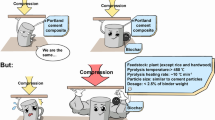Abstract
Cellulose fibres have already been applied commercially as an alternative to asbestos in fibre-cements composites. In spite of their industrial scale production for more than 20 years, these composites still require much research efforts, which focus mainly on durability aspects. The influence of the most relevant deterioration mechanisms can be minimized if mineral admixtures with high pozzolanic activity replace ordinary Portland cement (OPC). The improvements then achieved are due to the decrease in Ca(OH)2 content and the more compact matrix and interfaces in the composite. In this respect, rice husk ash (RHA) is one of the most promising materials to be applied as a partial cement replacement in the cellulose-reinforced cement-based composites. This is due to the high active silica content of the ash and the widespread availability of the husks. To assess the influences of different chemical compositions of RHA, and the effects of autoclave curing on the pore characteristics of bamboo-pulp-reinforced cement composites, a comparative study was carried out in which pore characteristics were assessed by mercury intrusion porosimetry (MIP). Complementarily, the effects exerted by changes in the pore structure of the composites on their water permeability are evaluated by analytical and experimental approaches. It was observed that the incorporation of RHA in the composites could cause an extensive pore refinement in the matrix and in the interface layer, thereby decreasing water permeability. The results indicate that partial replacement of cement by RHA can improve the durability characteristics of cellulose–cement composites.









Similar content being viewed by others
References
Studinka JB (1989) Int J Cem Lightweight Concr 11:73
Coutts RSP (1988) In: Swamy RN (ed) Natural fibre reinforced cement and concrete. Blackie and Son Ltd, Glasgow, 1pp
Sharman WR, Vautier BP (1986) Dur Build Mat 3:255
Gram HS, Persson H, Skarendhal A (1984) In: Natural Fibre Concrete (SAREC, Stockholm) 5pp
Soroushian P, Marikunte S (1984) In: Daniel JI, Shah SP (eds) Fiber reinforced concrete: developments and innovations. American Concrete Institute, 73pp
Canovas ME, Selva NH, Kawiche GM (1992) Mat Struct 25:417
Macvicar R, Matuana LM, Balatinecz JJ (1999) Cem Concr Comp 21:189
Toledo Filho RD, Ghavami K, England GL, Scrivener K (2003) Cem Concr Comp 25:185
Yu Q, Sawayama K, Sugita S, Shoya M, Isojima Y (1999) Cem Concr Res 29:37
FAO (2004) In: Rice market monitor, vol VII, issue 4, (Food and Agriculture Organization for the UN, http://www.fao.org/es/ESC/en/20953/21026/highlight_23001en_p.html, 9th Sept)
Cook DJ (1986) In: Swamy RN (ed) Cement replacement materials. Blackie & Son Ltd, London, 171pp
Stroeven P, Bui DD, Sabuni E (1999) Fuel 78:153
Bui DD (2001) In: Rice husk ash as a mineral admixture for high performance concrete, Delft University Press, Delft, 13pp
Brown PH, Shy D, Skalny J (1991) In: Skalny J, Mindess S (eds) Materials science of concrete II. The American Ceramic Soc. Inc, 83pp
Aldea CM, Young F, Wang K, Shah SP (2000) Cem Concr Res 30:465
Metha PK, Monteiro JP (1993) In: Concrete: structure, properties and methods. Prentice Hall, New Jersey, 26pp
Winslow DN, Lovell CW (1981) Powder Tech 29:151
Diamond S (2000) Cem Concr Res 30:1517
Ye G (2003) In: Experimental study & numerical simulation of the development of the microstructure and permeability of cementitious materials. Delft University Press, Delft, 43pp
Hedenblad G (1997) Adv Cem Based Mat 6:123
El-Dieb AS, Hooton RD (1994) Cem Concr Res 24:443
Banthia N, Mindess S (1989) Cem Concr Res 19:727
Katz AJ, Thompson AH (1986) Phys Rev B 34:8179
Tumidajski PJ, Lin B (1998) Cem Concr Res 28:643
Christensen BJ, Mason TO, Jennings HM (1996) Cem Concr Res 26:1325
Cui L, Cahyadi JH (2001) Cem Concr Res 31:277
Garboczi EJ (1990) Cem Concr Res 20:591
Garboczi EJ, Bentz DP (1996) Constr Build Mat 10:293
Bentz DP, Garboczi EJ (1991) Cem Concr Res 21:325
Allen T, Marshall K (1972) In: The electrical sensing zone method of particle size measurement: the Coulter principle. University of Bradford, England, 105pp
Luxán MP, Madruga F, Saavedra J (1989) Cem Concr Res 19:63
Campbell MD, Coutts RSP (1980) J Mat Sci 15:1962
Muniz ES (2003) In: Desenvolvimento de Equipamento e Metodologia de Testes para Avaliação da Interação Folhelho-Fluido de Perfuração. Doctorate thesis, Pontifícia Universidade Católica do Rio de Janeiro, Rio de Janeiro, in Portuguese, 41pp
Frydman M, Fontoura SAB (2001) In: Proceedings of the Latin American and Caribbean Petroleum Engineering Conference. Buenos Ayres, 8pp
Matte V, Moranville M (1999) Cem Concr Comp 21:1
Acknowledgements
This study was financially supported by CNPq–National Council for Scientific and Technology Development, Brazilian Ministry of Science and Technology, and was developed at Delft University of Technology as a cooperation project supported by CICAT–Management Centre for International Cooperation. The authors are grateful to Doctor Eudes Siqueira Muniz, from the Petroleum Engineering and Technology Group-GTEP/PUC-Rio, for making possible the experimental study on permeability with the diffusion cell.
Author information
Authors and Affiliations
Corresponding author
Rights and permissions
About this article
Cite this article
de Souza Rodrigues, C., Ghavami, K. & Stroeven, P. Porosity and water permeability of rice husk ash-blended cement composites reinforced with bamboo pulp. J Mater Sci 41, 6925–6937 (2006). https://doi.org/10.1007/s10853-006-0217-2
Received:
Accepted:
Published:
Issue Date:
DOI: https://doi.org/10.1007/s10853-006-0217-2




